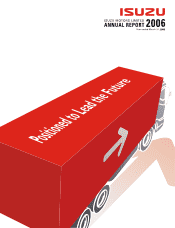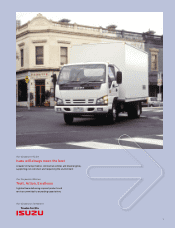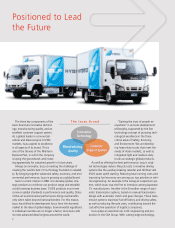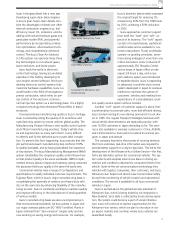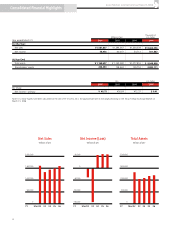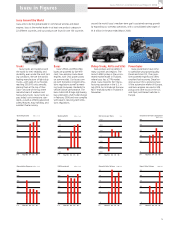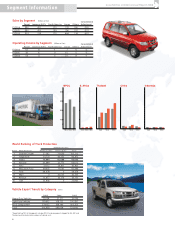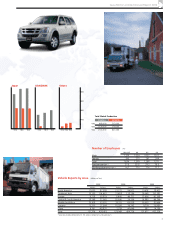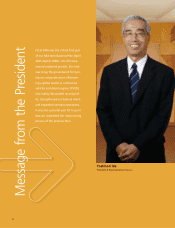Isuzu 2006 Annual Report Download - page 5
Download and view the complete annual report
Please find page 5 of the 2006 Isuzu annual report below. You can navigate through the pages in the report by either clicking on the pages listed below, or by using the keyword search tool below to find specific information within the annual report.
3
Isuzu Motors Limited Annual Report 2006
Isuzu is bringing diesel into a new age.
Developing super-clean diesel engines
is Isuzu’s goal. Super-clean diesels com-
bine the advantages of diesel over other
internal combustion engines (e.g., fuel
efficiency, lower CO2 emissions, and du-
rability) with reduced exhaust gases and
particulate matter (PM), and powerful
performance by incorporating combus-
tion optimization, after-treatment tech-
nology, and comprehensive electronic
control. The Isuzu Clean Air Solutions
(I-CAS) system can optimize these three
key technologies to cut exhaust gases,
lower emissions, and boost power.
Isuzu leads the world in electronic
control technology, having accumulated
expertise in this field by developing its
own engine control software. Striving to
develop electronic control systems that
maximize hardware capabilities, Isuzu is a
world leader in the field of homogenous
premix combustion, which relies on pre-
cise control of the electronic common-
rail fuel injection system as a technology base. It is a highly
complex technology that eliminates PM and NOx in diesel
emissions.
Uncompromising manufacturing quality is Isuzu’s heritage.
Isuzu is constantly raising the quality of its workforce and
manufacturing system to ensure uniform global quality. The
Manufacturing Division follows a strict quality control system
and efficient manufacturing practices. Today’s vehicle chas-
sis and engines have so many parts that it is very difficult
to identify and fix the defective part or parts after comple-
tion. To prevent this from happening, Isuzu ensures that the
job performed at each manufacturing step conforms 100%
to quality standards, and by having specialized line inspectors
at key sections. The Isuzu Manufacturing Management (IMM)
system standardizes the company’s quality control know-how
so that product quality is the same worldwide. IMM is imple-
mented at Isuzu plants in Japan and overseas, giving customers
the assurance that Isuzu quality is the same the world over.
Commercial vehicles have a range of configurations and
specifications to satisfy individual customer requirements. The
Fujisawa Plant, which is Isuzu’s major manufacturing base, is
consolidating the assembly of medium and heavy-duty vehi-
cles on the same line by enhancing flexibility of the manufac-
turing process. Isuzu is constantly working to maintain quality
and improve efficiency in the manufacture of small quantities
of various models.
Isuzu’s manufacturing bases are also uncompromising in
their environmental standards. All Isuzu plants in Japan and
our major overseas plants are ISO 14001 certified. Plants in
Japan achieved their “zero emission” targets early and are
now working on saving energy and resources. For example,
Isuzu’s domestic plants easily surpassed
the original target for reducing CO2
emissions by 30% from the 1990 level
by 2010, achieving a 50% reduction
in 2003.
Isuzu approaches customer support
from both the “hard” and “soft” as-
pects of its business. The “soft” aspect
consists of comprehensive, sophisticat-
ed after-sales service available to cus-
tomers everywhere. Trucks worldwide
operate on grueling schedules, some-
times doing mileages of more than one
million kilometers. Isuzu’s network of
approximately 250 Ohayaku Center
service bases in Japan offers on-site
repairs 24 hours a day, and a new
parts delivery system was introduced
to expedite repairs. Isuzu is expanding
its advanced, round-the-clock service
system developed in Japan to overseas
markets to maximize the uptime of
customers’ vehicles and meeting their
expectations of a standardized, excel-
lent quality service system without borders.
Another “soft” aspect of customer support is about shar-
ing information to promote safer, more fuel-efficient driving.
Isuzu started running its own driving seminars for truck driv-
ers in 1995. The regular Transport Strategies Seminars with
actual vehicle demonstrations are especially popular, with
over 10,000 customers in Japan attending so far. This semi-
nar is also available to overseas customers in China, ASEAN,
and Central America. Isuzu plans to extend its seminar pro-
gram in Japan and abroad.
The company learned in the process of running seminars
that more extensive, real-time information was required to
provide better support on a day-to-day basis. This led to the
development of the Mimamori-kun Online Service—the first,
full-scale telematics system for commercial vehicles. The sys-
tem collects and analyzes voluminous data on driving op-
erations and conditions obtained by computers fitted to the
vehicle. State-of-the-art communications technology links
vehicles with logistics companies, their customers, and Isuzu.
Mimamori-kun helps truck drivers save fuel and drive safely
by real-time monitoring of vehicle location and operational
conditions. The service is available for all Isuzu commercial
vehicles in Japan.
Isuzu is excited about the global business potential of
Mimamori-kun, which is being trialed by six companies in
New Zealand. Since data is collected by trucks during opera-
tion, the system could become a part of social infrastruc-
ture. Isuzu will continue to explore opportunities for the
Mimamori-kun service, which we plan to introduce in ma-
jor export markets and countries where Isuzu vehicles are
assembled locally.
Gala Heavy-Duty Bus
Giga Series Heavy-Duty Truck
Converter for Mimamori-kun
Online Service

